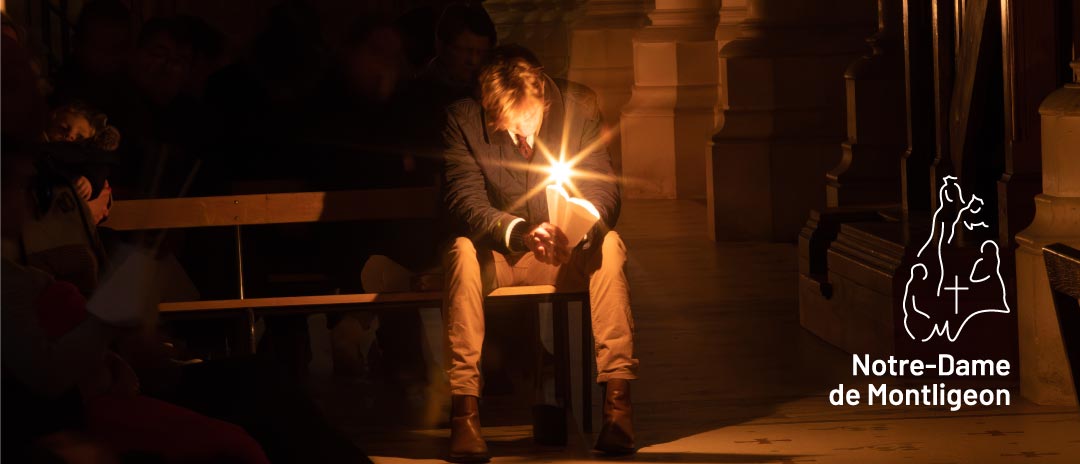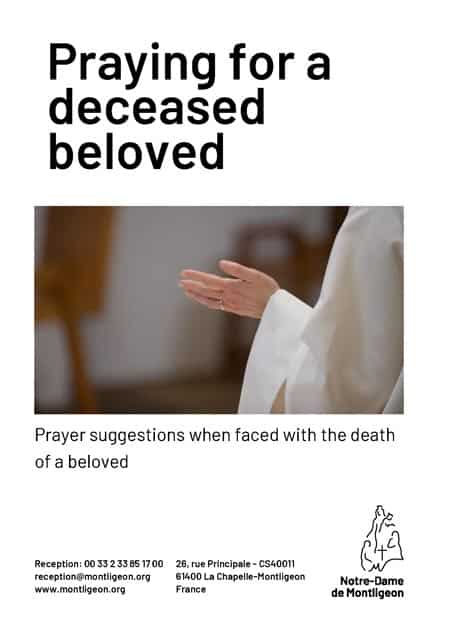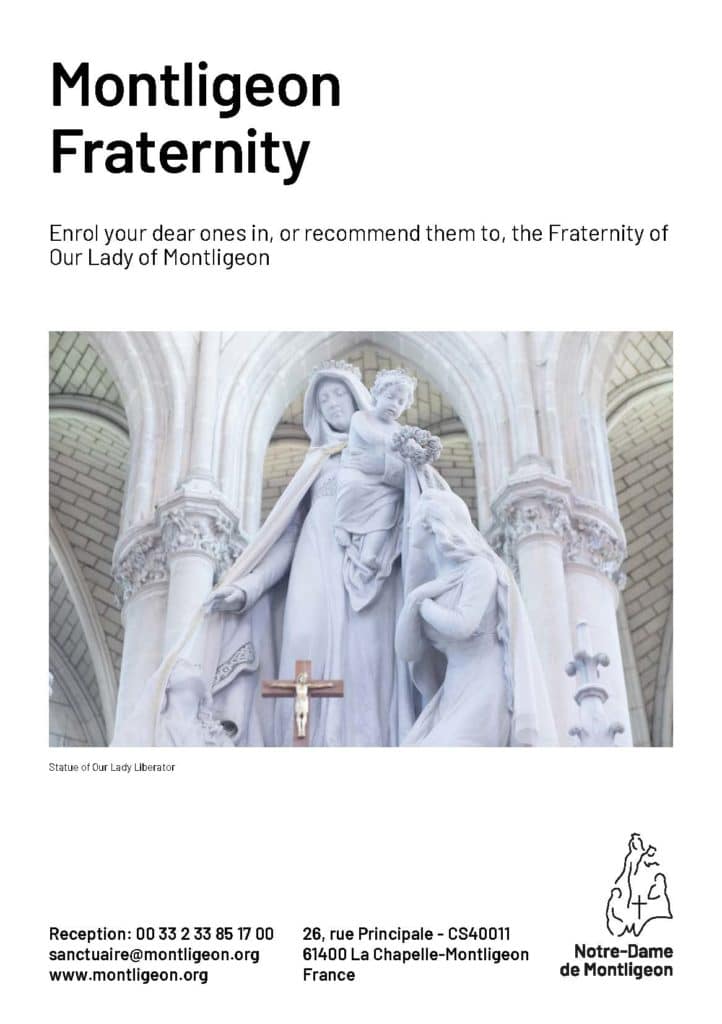Praying for the dead or praying for the deceased?
Should we qualify our beloved departed as “dead” or as “deceased”? Death is a refutation of life. According to its Latin etymology, the deceased is a person whose life is over. For the Catholic Church, the deceased is one who has not entirely reached Heaven, and who needs our prayers to achieve purification after demise.
About death
Is death an inconceivable scandal, as alluded by French Philosopher Philippe Ariès? What connexion between suffering and death? If none, better consider the latter as irrelevant, and discard it!
Seemingly the prevailing attitude in this day and age is to stall the subject, for either it hassles us or dismays us. Death related news and headlines capture all interest, especially when they relate to people in remote places. Death has become a painless and meaningless topic when it comes to video games, where one may die and be brought back to life at every “level”.
Yet, we are all concerned by death, moreover, in a most intimate way. With havocs due to global warming and the 2020 pandemic, all of a sudden it seems to have reached our doorstep . When death takes my beloved, I can escape the matter no longer. I have to choose what to believe in.
What happens at the moment of death?
At metaphysical level, when death occurs, soul and body separate. The body becomes a corpse. Lifeless, it is destined to decay.
The immortal soul is judged and straightaway receives its retribution, either entry in the Beatitude, immediate or subsequent to purification, or eternal damnation.
Jugement sole criteria is love.
My death? How should I prepare for it?
What about death? Who could tell all that it entails? Yet we all know that it surely awaits us at the end of our earthly journey and that it is a chief moment in our life. In the meantime, to confront oneself to the idea of dying is essential in order to apprehend one’s life with self-determination.
Montligeon shrine Rector, Re. Fr. Don Paul Denizot’s interview by French Catholic Radio journalist, Guillaume Desanges (RCF)
Is it legitimate to fear death?
By all means! For death is ruthless, spares no one, and appears to be the supreme obstacle to our craving for love and for life. Who wants to face it?
Jesus Himself at Gethsemane felt sheer fright as death approached. Fearing death confirms that we are not intended for death but for life.
Have we been created for death?
From a common standpoint, death is an obvious and natural component of the world we live in, as nature corroborates day after day. Likewise death is against nature for the Scriptures tell us that man was not made for dying. For death came into the world as the salary for sin, because man turned away from God. However, ensuing Christ Jesus, dying brings us back to life. In Jesus’ death we can observe two kinds of approach, that of confrontation and will faced with letting go so as to accept death, pathway to ever lasting life.
Montligeon shrine chaplain, Fr. Don Guillaume d’Anselme’s interview by French Catholic Radio journalist Guillaume Desanges (RCF)
“Dying He destroyed our death, rising He restored our life”
The mystery of death
Gaudium et Spes n°18.
“It is in the face of death that the riddle a human existence grows most acute.
Not only is man tormented by pain and by the advancing deterioration of his body, but even more so by a dread of perpetual extinction.
He rightly follows the intuition of his heart when he abhors and repudiates the utter ruin, and total disappearance of his own person. He rebels against death because he bears in himself an eternal seed which cannot be reduced to sheer matter. All the endeavors of technology, though useful in the extreme, cannot calm his anxiety; for prolongation of biological life is unable to satisfy that desire for higher life which is inescapably lodged in his breast.
What of love, once death has occurred?
From a mere human standpoint, death is an ignominy, a disgrace for when we love someone, it is meant to endure for ever. Thus, what does become of our love when our loved ones have died?
Love will last for ever. “Charity is eternal.”
Montligeon shrine chaplain, Rev. Fr. Don Thomas Lapenne’s interview by French Catholic Radio journalist Guillaume Desanges (RCF)
Although the mystery of death utterly beggars the imagination, the Church has been taught by divine revelation and firmly teaches that man has been created by God for a blissful purpose beyond the reach of earthly misery.
In addition, that bodily death from which man would have been immune had he not sinned(14) will be vanquished, according to the Christian faith, when man who was ruined by his own doing is restored to wholeness by an almighty and merciful Saviour.
For God has called man and still calls him so that with his entire being he might be joined to Him in an endless sharing of a divine life beyond all corruption.
Christ won this victory when He rose to life, for by His death He freed man from death.”
Christ, the new creation
On the Church in the modern world (chapitre I) Man’s calling.
Gaudium et Spes n°22.
“For, since Christ died for all men, and since the ultimate vocation of man is in fact one, and divine, we ought to believe that the Holy Spirit in a manner known only to God offers to every man the possibility of being associated with this paschal mystery.
(…) All this holds true not only for Christians, but for all men of good will in whose hearts grace works in an unseen way.
Such is the mystery of man, and it is a great one, as seen by believers in the light of Christian revelation. Through Christ and in Christ, the riddles of sorrow and death grow meaningful. Apart from His Gospel, they overwhelm us. Christ has risen, destroying death by His death; He has lavished life upon us so that, as sons in the Son, we can cry out in the Spirit; Abba, Father!”
Montligeon,
a shrine devoted to praying for the dead
Exerpts from Rev. Fr. don Paul Denizot’s interview for The Gospel of Life
Our Lady of Montligeon is altogether a spiritual Fraternity initiated in 1884 and its HQ, and a catholic shrine that hosts pilgrimages and retreats. The core of its mission is to pray and initiate praying for the dead. Perpetual Mass is celebrated on a daily basis at the shrine for the souls in purgatory, and for enrollees, living or deceased, recommended to the Fraternity.
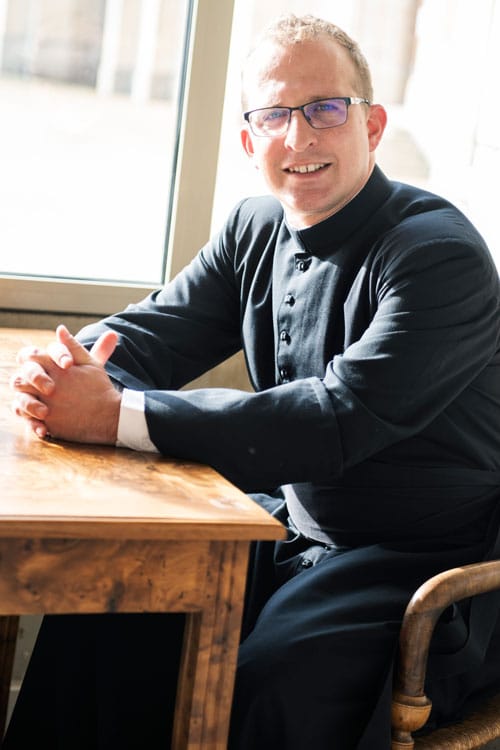
Rev. Fr. Paul Joseph Buguet (+1918), parish priest of the village of La Chapelle Montligeon (Diocese of Séez), committed to the social Catholic doctrine, sought to provide destitute parishioners with employment. He tried his hand at several entreprises that soon folded.
In 1876, Fr. Buguet underwent three tragic deaths in his closest family: that of his brother Auguste, crushed by the bell of neighborhing Mortagne parish church, followed by that of both his nieces, grief-stricken after their father’s demise. He thus felt confirmed in his notion of establishing a work for the deliverance of forsaken souls from Purgatory.
Tireless missionary, il initiated a printing press manufacture to diffuse the message of Montligeon, thus providing work to laborers. The spiritual Fraternity swiftly developed through Europe and worldwide. It presently numbers over 800 Montligeon Prayer Groups in numerous countries.
Father Buguet was also a builder. As early as 1896, so as to host the growing crowds of pilgrims, he undertook to have the future basilica of Our Lady of Montligeon erected, it later would be called “the Cathedral in the fields”. Altogether a prayer and a retreat center, it hosts groups, families, and individual visitors the whole year through.
During the ‘Heaven’s Pilgrimages‘ held throughout the month of November, the shrine receives innumerable pilgrims.
Praying for the souls in Purgatory, what does it mean?
Praying for the souls in Purgatory, above all is believing that one’s prayer can touch hearts, even beyond death.
It also means believing in the Lord taking care of our dead and that He offers His Mercy to those who were not quite ready to enter into His Glory. In the Bible, we have a testimony of prayer for the dead in Macchabees (Ma 12, 43-46) when Judas organises a collect so as to have a sacrifice celebrated for the warriors of Israel slained during a battle. The narrator adds: “It is therefore a holy and wholesome thought to pray for the dead, that they may be loosed from sins.”
As Catholics, we believe that our prayer can support the deceased during the post mortem purification that the Church calls Purgatory.
Do I have a soul?
A person is altogether a body and a spiritual being. The soul designates the spiritual principle of every human being, the innermost of his being, of his conscience, also called “heart”.
The soul is shaping the being, i.e. it renders the human body alive with its living source. Immortal, it is created by God at our conception and from then on, remains acutely united to our body. Body of our soul and soul of our body. At our death, the soul disengages from our body, and awaits to be ultimately reunited with our body at the final Resurrection.
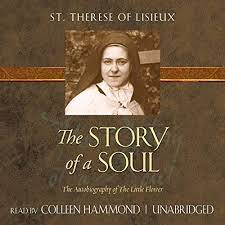
Saint Augustine thus recounted the death of St. Monica, his mother, and her last words:
Then, upon seeing us burdened with sadness, she said: “Bury your mother here.” I kept silent while holding back my tears. As for my brother, he said a few words to her: that she should not be wishing to die in a foreign land but, as a happier fate, in her homeland. As she listened to him, my mother showed an anxious face and stared at him with a gaze of reproach for such a thought. Then she looked at me, “See what he says.” Then, speaking to both of us, she said: “Put this body anywhere. Do not let care about it disturb you. I ask only this: that you remember me at the altar of the Lord, wherever you may be.” [Confessions 9, 11, 27] . After uttering this sentence, searching for words, she remained silent for her illness was worsening and making her suffer.
Saint Augustine, Confessions, BA 14 IX, XI, 27.
“Do not weep, my children; I shall be more useful to you where I am now going, than I have ever been in this life.” St Dominic, to his brethren, Jourdain de Saxe, lib. 93, as he was dying, Catholic Church Cathechism N°956.
What is Purgatory?
Purgatory is a state of purification after death.
“All who die in God’s grace and friendship, but still imperfectly purified, are indeed assured of their eternal salvation; but after death they undergo purification, so as to achieve the holiness necessary to enter the joy of heaven.”
Catechism of the Catholic Church, n°1030.
In the sacrament of confession, the Lord forgives sins, but remain in us the effects of these sins, addictions or weaknesses. In Heaven not one inch of egoism or pride can occur. The purgatory is thus a time of restoration that allows for recovering from the later, so as to gain entry in the Glory of God. For Saint John Vianney of Ars, “Purgatory is our good God’s hospital…”
Who goes to Purgatory?
All who die accepting God’s love and asking forgiveness for their sins, but who are not quite ready to fully communicate with God’s Holiness in Glory.
Saint Catherine of Genoa, fifteenth century mystic, wrote a treaty on purgatory where she disclosed that the souls do not go to Purgatory against their will; on the contrary, feeling not prepared enough they themselves choose to be purified before entering into the full communion with Love.

Bro. Adrian’s explanations for Purgatory.
What does one do in Purgatory?
In Purgatory, one waits. It is a state of altogether joy, for one is assured of salvation and, moreover, souls are in God’s grace and love; yet it means suffering for the desire for Heaven does not stop but increases ever more without it being satisfied. Here on earth, a betrothed after experiencing a long separation longing for his or her future spouse cannot get contented by merely reading a book, using a smartphone, or by any other activity… In Purgatory none of these things to help spend time, only the ever more burning desire to reach a complete state of restoration.
What relations between the living on earth and the souls in Purgatory?
Souls undergoing purification cannot help themselves. However, they expect the petitions of the Saints and ours as well, as we are still here on earth.
Our prayers and petitions, no matter how poor, are of great help to them in the state of purification they undergo, according to many a testimony, like that of St Teresa of Avila, Saint Faustina or Saint Pio of Pietrelcina (Padre Pio).
As the Catholic Catechism underlines (n°958), the souls in Purgatory are not ungrateful, “Our prayer for them is capable not only of helping them, but also of making their intercession for us effective.”
Can we enter into communication with our deceased?
“Yes, we can, by means of the communion of Saints!” explains Montligeon shrine chaplain, Rev. Fr. Don Martin Viviès in an interview by French Catholic Radio journalist Guillaume Desanges (RCF).
“After Marie entered the Carmel, and I no longer had her to listen to my scruples, I turned towards Heaven and confided them to the four little angels who had already gone before me, for I thought that these innocent souls, who had never known sorrow or fear, ought to have pity on their poor little suffering sister. (…). The answer was not long in coming; soon my soul was flooded with the sweetest peace. I knew that I was loved, not only on earth but also in Heaven. From that time my devotion for these little brothers and sisters increased; I loved to talk to them and tell them of all the sorrows of this exile, and of my wish to join them soon in our Eternal Home… !”
Therese of Lisieux, Story of a Soul.

shrine and Fraternity of Notre-Dame de Montligeon
The Rev. Father Buguet, who founded the charitable work of Our Lady of Montligeon, was much aware of such a communion, of this exchange of spiritual deeds between the living and the dead.
“I sought to reconcile a two-fold goal: to have people pray for neglected souls and, in return, to obtain from them the means of providing a livelihood for the worker. In my mind, it was like a “do ut des” [“I give what you give”] between the souls in Purgatory and the poor forsaken souls here on earth. It was a reciprocated deliverance.”
What about Hell,
does it exist?
“Hell does existIt is a state of internment by oneself… moreover, it is a deliberate personal choice.”
Montligeon shrine Rector, Re. Fr. Don Paul Denizot’s interview by French Catholic Radio journalist, Guillaume Desanges (RCF)
Hell is “this state of definitive self-exclusion from communion with God” (Catechism of the Catholic Church n°1033). Embedded in man’s freedom lies his capacity to accept or refuse God. What a mystery, yet, real.
The R.C. Catechism does not state that there are people in hell but asserts that one can say “No” to God, for ever. Even Judas who betrayed Jesus did not believe he could be forgiven, yet the R.C. Church continues to entrust him to the infinite Mercy of God.
What is the Perpetual Mass for the Souls in Purgatory?
Mass is the most beautiful prayer that one can offer, for it epitomizes the offering of Christ’s sacrifice to the Father.
The world is saved and renewed by His one and only sacrifice on the Cross. At each Eucharist, as members of the Body of Christ, we partake in the offering of this astonishing sacrifice, presented for the living and for the dead. At the shrine of Montligeon, Perpetual Mass is thus celebrated every day and for ever for the Souls in Purgatory, and for all enrolled in the spiritual Fraternity of Our Lady of Montligeon, whether living or deceased. You too may enroll yourself or recommend someone, children, grand-children, friends, etc., for further information click on “Montligeon Spiritual Fraternity” here on our website, or enquire by email at: sanctuaire@montligeon.org.
Suggestions of ways of praying for your beloved,
whether departing or already deceased
Praying for a dead person, how?
Whether at home, or in a church, outside or even in the underground… I can pray everywhere. In the innermost of my heart. Here are a few propositions.
How can I help my deceased one, how to go about my state of bereavement? I may not know how to pray, I might not even believe in God. Yet, I can always cry out to Him, I might say: “God, if you exists, have mercy on my beloved who passed away!” …
Praying for an unborn child
Often, no heed is paid to the death of the little ones. One thinks it best to keep their existence silent, seeking to avoid much suffering.
Moreover most people are convinced that one will quickly forget them since one did not have time to get attached to them. Yet, the suffering of the parents and their kin is nevertheless very real.
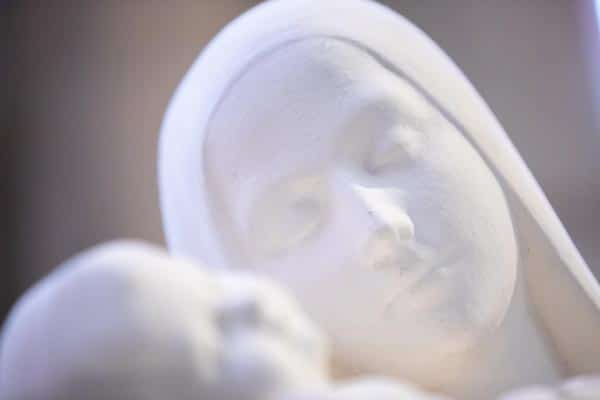
Every first Tuesday of the month, Holy Mass is celebrated for the unborn children (miscarriage, abortion) and for the little deceased children who did not get to be baptized.
Once a year, on the Sunday of Divine Mercy, the shrine of Montligeon holds a pilgrimage for the deceased little ones.
Praying with Montligeon, in bereavement or in mourning
Join the sanctuary prayer while remaining at home or when experiencing lockdown
To help you accompany a loved one dying without the opportunity of your being present, or to support you through with experiencing bereavement and having to remain away from the funerals, the shrine of Montligeon proposes two booklets of prayers, for private individual, or family use.
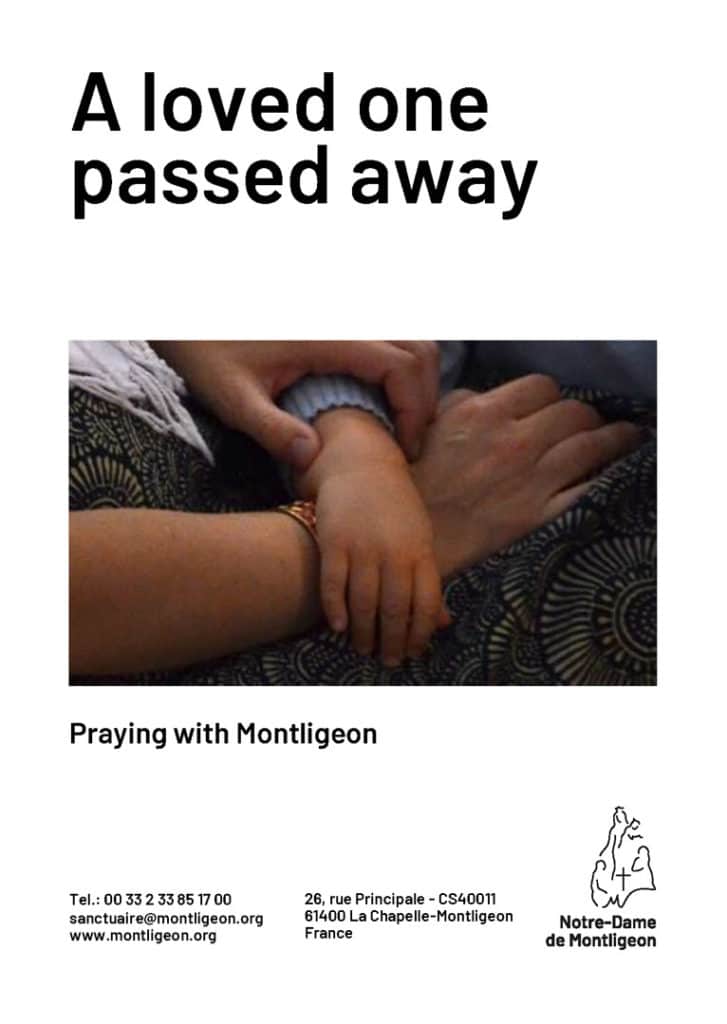
Amidst this very state of solitude, I am invited to unveil a presence, that of the resurrected Lord Jesus Christ, and moreover, that of the communion of saints, of all Souls, as well as that of the deceased for whom I wish to pray presently.
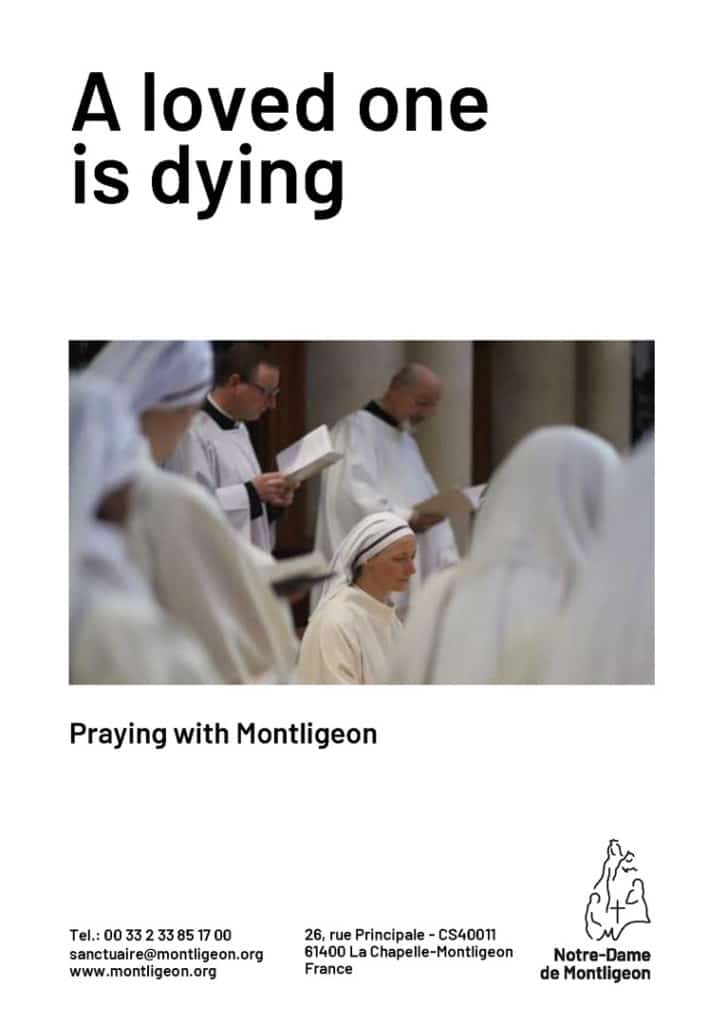
In such a painful circumstance, I can nevertheless offer my grief, my prayers, and my keeping watch for the one who is about to remit his or her life into the hands of God. In faith, I remain confident that I can still do something for his or her, and that my prayers will truly bear fruit.
Vsit the shrine of Montligeon
Take a break, experiment prayer and silence, in a beneficial environment. You may ask to meet a priest or nun. The chaplains and the Sisters ministering at the shrine are available to meet you, for support, counsel, etc. Feel free to take part in the liturgy on avail every day (Mass, divine office, Rosary, Holy Hour, confessions…).
The “Thank you/Sorry” card
It entails writing a card to a deceased person to whom we would have liked to express our gratitude, or from whom ask for forgiveness, and whom we would like to entrust to Our Lady’s intercession, and in the communion of Saints.
The Way of the Resurrection
The Way of Light was inspired by the Way of the Cross. Station after station, it proposes to follow Christ in His resurrection and apparitions. It seeks to help us open up to hope, for ourselves and for our beloved deceased. We can walk the path of inner healing.
Request a Mass, or a novena of Masses (celebrated 9 consecutive days), or a Gregorian Mass (celebrated 30 consecutive days), for your loved ones.
It means asking the Church to attach in a special way to your beloved the merits of Christ Jesus’ passion and death.
Our Lady of Montligeon Prayer Groups
Throughout France and worldwide, prayer groups affiliated to Our Lady of Montligeon Fraternity meet on a regular basis, – either weekly or monthly – and pray for the deceased, especially the most forgotten, and for all enrolled in the spiritual Fraternity of Montligeon.

